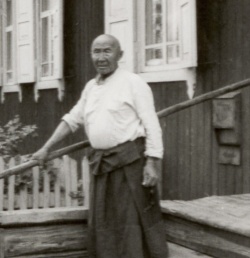Buryat language
Buryat (Buriat) /ˈbʊriæt/[1] (Buryat Cyrillic: буряад хэлэн buryaad khelen) is a variety of Mongolic spoken by the Buryats that is classified either as a language or as a major dialect group of Mongolian. The majority of Buryat speakers live in Russia along the northern border of Mongolia where it is an official language in the Buryat Republic, Ust-Orda Buryatia and Aga Buryatia.[2] In the Russian census of 2002, 353,113 people out of an ethnic population of 445,175 could speak Buryat (72.3%). Some other 15,694 can also speak Buryat, mostly ethnic Russians.[3] There are at least 100,000 ethnic Buryats in Mongolia and the People's Republic of China as well.[4] Buryats in Russia have a separate literary standard, written in a Cyrillic alphabet.
Dialects
The delimitation of Buryat mostly concerns its relationship to its immediate neighbors, Mongolian proper and Khamnigan. While Khamnigan is sometimes regarded as a dialect of Buryat, this is not supported by isoglosses. The same holds for Tsongol and Sartul dialects, which rather group with Khalkha Mongolian to which they historically belong. Buryat dialects are:
Khori group east of Lake Baikal comprising Khori, Aga, Tugnui, and North Selenga dialects. Khori is also spoken by most Buryats in Mongolia and a few speakers in Hulunbuir.
Lower Uda (Nizhneudinsk) dialect, the dialect situated furthest to the west and which shows the strongest influence by Turkic
Alar–Tunka group comprising Alar, Tunka–Oka, Zakamna, and Unga in the southwest of Lake Baikal in the case of Tunka also in Mongolia.
Ekhirit–Bulagat group in the Ust’-Orda National District comprising Ekhirit–Bulagat, Bokhan, Ol’khon, Barguzin, and Baikal–Kudara
Bargut group in Hulunbuir (which is historically known as Barga), comprising Old Bargut and New Bargut[6]
Based on loan vocabulary, a division might be drawn between Russia Buriat, Mongolia Buriat and China Buriat.[7] However, as the influence of Russian is much stronger in the dialects traditionally spoken west of Lake Baikal, a division might rather be drawn between the Khori and Bargut group on the one hand and the other three groups on the other hand.[8]
Phonology
Buryat has the vowel phonemes /i, ə, e, a, u, ʊ, o, ɔ/ (plus a few diphthongs),[9] short /e/ being realized as [ɯ], and the consonant phonemes /b, g, d, th, m, n, x, l, r/ (each with a corresponding palatalized phoneme) and /s, ʃ, h, j/.[10] These vowels are restricted in their occurrence according to vowel harmony.[11] The basic syllable structure is (C)V(C) in careful articulation, but word-final CC clusters may occur in more rapid speech if short vowels of non-initial syllables get lost.
